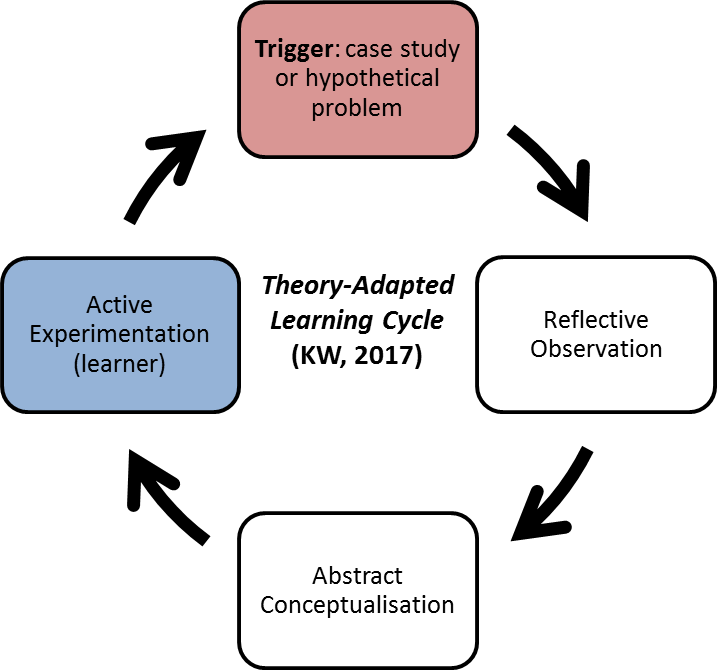Flex 1. Delivering Practical Sessions
Activity: Delivering Practical Sessions
Date: April 3, 2017
Summary and Rationale (“What?”)
This was a three-hour workshop designed to suggest techniques and provide “creative space” for considering different practical activities to enhance teaching.
My interest in practical activities began 2014, when I devised The Supply Chain Game for level VII students and observed astonishing engagement and enthusiasm for the game. I participated in this workshop to gather and trial ideas for other practical activities that facilitate the teaching of abstract, conceptual material.
Relevance to Practice (“So What?”)
Most of the key concepts I teach I illustrate using animated slides. These show how material flows through systems, how bottlenecks occur, how inventory levels can be managed, etc. Animation depicts accurately, but engages weakly. This is probably because the students are heavily exposed to PowerPoint and any visual stimuli can only be received passively. To deepen learning and to make the abstract more real, practical activities are probably beneficial. However, creating original and unique activities for each tutorial is probably an unrealistic goal. Instead, a single method that generates activities/creative work performed by the student is likely much more practicable.
What I Learnt About My Practice (More “So What?”)
With the exceptions discussed above, most of my teaching was and remains didactic. Students receive information passively; tutorials are extensions of lectures with the occasional activity included. To a degree, the nature of the subject limits classroom options. Most Operations Management is abstract and alien to undergraduates who lack work experience.
The Literature (Even More “So What?”)
Three theories constituted the focal content of this workshop.
- Tell, Show, Do
Addleston (1959) developed TSD for paediatric dentistry, drawing, presumably, on the method developed by Allen in the 1940s: Tell, Show, Do (or Apply), and Check (or Review).
TSD(C) is of limited applicability when teaching theoretical material. Both methods likely have more value in training, which focusses on the acquisition of tangible skills such as dexterity with equipment or software. This limitation notwithstanding, aspects of the TSD(C) can, I believe, be utilised through creative triggers in the teaching of my subject (more on this later).
- Dave’s Psychomotor Domain Taxonomy (1977)
Dave proposed a series of stages through which learners ascend (similarities with the models of Maslow and Piaget are striking). The step pyramid theorizes acquisition of physical skills (hence “psychomotor”, as in Bloom’s Taxonomy). Dave receives little discussion here because his model is of limited application in the teaching of my discipline, which requires no learning of physical skills.
- Kolb’s ELC
The ELC (1984) is probably best suited to the pedagogic context for which it was originally developed. Its applicability to andragogy – particularly in the teaching of abstract material – is less apparent. This is because the experiential dimension of the cycle is narrow when the material to be learnt is conceptual, theoretical, or abstract in nature. Rare is the student who has experiential knowledge of any Operations Management concept.

Opportunities for Change (“Now What?”)
The weaknesses of both TSD(C) and the ELC can, I believe, be addressed: in the TSD(C), “Tell” could be applied in the creation of triggers; in the ELC, “Concrete Experience” could be replaced by an appropriate student- or tutor-selected trigger.
The Trigger-Adapted TSD(C)
A case study – the preferred method at Harvard Business School (Ellet, 2007) – could be used to establish context, present a problem, and thereby trigger reflection and solution. This would lead logically and intuitively into the theoretical content of the tutorial. Such an approach also incorporates meta-cognition, since it provides reasons for the existence of the theory and justifies the content of the taught material.
“Show” could be a creative activity: verbal explanation, video, or printed diagrammatic material. Whatever form “Tell” takes, this phase supplements or extends the information presented in the “Tell” phase. “Tell” and “Show” thus deliver the trigger.
The solution-creation effort becomes the “Do” phase, which can also be creative – students create a solution and explain it however they choose. Interestingly, Kolb’s “Active Experimentation” could occur in the “Do” phase, since students might be able to demonstrate their solution against hypothetical constraints.

The Theory-Adapted Learning Cycle
The ELC’s “Concrete Experience” is substituted by the experience of others, such as a problem-illustrative case study, or a hypothetical problem that invokes remedy by the method or theory about to be taught (ideally, students will reach that method through guided deduction rather than by receiving explanation).
“Reflective Observation” – in which students consider the case and use prior learning to identify factors – follows, and is in no major way modified. In the “Abstract Conceptualisation” phase, students attempt to conceptualise the most important aspects of the case study and/or test previously learnt concepts against the case study.
The “Active Experimentation” of the ELC must also be revised. Students will rarely have the resources to directly compare competing business strategies; hence the experimentation must involve the creation of a simulation or hypothetical instance/model.

Action Plan
Based on what I learnt from this workshop, I propose to implement the following in future teaching.
- Apply the Trigger-Adapted TSD in tutorial planning. This simple method features a trigger (case study or other catalyst) that initiates a creative, independent student response. This method ensures that no two tutorials can ever be exactly the same.
- Develop creative triggers to initiate the TSD cycle: case studies, news stories, product presentations, brainstorming, mind mapping, etc.
- Apply the Theory-Adapted Learning Cycle in the planning of learning-facilitating activities/games. Whenever the material permits, build tutorial sessions around creative activities appropriate to the stage and content of the curriculum.
- Experiment with both the Trigger-Adapted TSD and the Theory-Adapted Learning Cycle to ascertain which produces the more effective learning and generates more creativity in student engagement.
Further Reading/Related CPD Activity
(Review the following links and literature; attend any/all Employability-related workshops and events. A more detailed account of how the adapted TSD and ELC could be combined and suggestions for creative activities that could be used within the phases of these merged models can be found here.)
Lego ® Serious Play ® creative interaction workshop at CELT.
Beaney, M. (2005) Imagination and Creativity. Milton Keynes: Open University Press.
References
Bolton, G. (2014) Reflective practice: writing and professional development. 4th edn. London: Sage.
Ellet, W. (2007) The case study handbook: how to read, discuss, and write persuasively about cases. Brighton, MA: Harvard Business Review Press.
Manchester Metropolitan University Strategy for Learning, Teaching and Assessment (2011) [Online]. Available at: http://www.celt.mmu.ac.uk/ltastrategy/ (Accessed: 23 May 2017)
Kolb, D. (1984) Experiential learning: experience as the source of learning and development. Englewood Cliffs, New Jersey: Prentice-Hall.
Rolfe, G., Freshwater, D. and Jasper, M. (2001) Critical reflection for nursing and the helping professions: a user’s guide. Basingstoke: Palgrave Macmillan.
